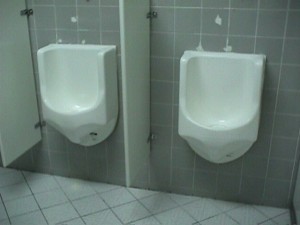If I were to write an article on restroom trends in high-rise properties in the mid-1990s or 2000s, the emphasis would likely have been on luxury. The “functional look” of commercial restrooms, commonly found in the 1980s and earlier, was no longer en vogue. It had been replaced with marble, granite, and high-end restroom fixture designs.
However, the recent economic downturn has changed that. While we aren’t necessarily returning to bland functionalism, two trends emerge as new high-rises are built and existing ones are updated:
- A greater emphasis on making high-rise restrooms easier to clean and maintain.
- Restroom fixtures that are more water efficient.

Substantial savings in maintenance costs can be achieved by the installation of no-water urinals.
Cleaning & Maintenance
The first trend evolved because building owners are under ever greater pressure to reduce operating costs. While janitorial/maintenance costs vary, according to the Institute of Real Estate Management (IREM), they account for one of the largest portions of a facility’s overall operating costs. This is typically about 25 percent in downtown commercial properties, which includes high-rise buildings.
Restrooms, as facilities managers and custodial workers know, are some of the most difficult, time-consuming, and costly areas to clean.
To rectify this situation, designers and developers are taking the following steps to make high-rise restrooms easier to clean:
- Installing touch-free fixtures. While the initial goal of these fixtures was to improve hygiene, they can also reduce waste, minimize vandalism, and reduce the surfaces needing to be cleaned in a restroom.
- Installing no-water urinals. These systems don’t require the cleaning attention of conventional urinals because water deposits don’t build up; because they’re dry, bacteria don’t thrive on inner urinal surfaces.
- Using light-colored countertops, which tend to camouflage soil and water spills; also, using continuous-surface countertops make it easier to maintain.
- Installing “jumbo” dispensers for toilet paper and roll paper towels to reduce re-stocking frequencies.
- Placing trash receptacles next to countertops and exit doors; this enables the user to open the door using a paper towel and then toss it in the receptacle and not on the floor.
- Looking for alternatives to tile and grout floors and walls. These can be difficult to clean and often require the use of powerful chemicals, especially to clean grout areas.
- Installing lids on toilets. Closing lids on toilets during the flushing process helps prevent the dissemination of microbes, which can soil walls, partitions, and floors.
- Installing partitions that hang from the ceiling and aren’t attached to the floor; this small change makes it easier to clean under partitions and avoids soil build-up in corners.
- Installing electrical outlets higher on walls. Having electrical equipment power cords on floors can slow worker productivity and cause a trip and fall.
Water Considerations
As has been widely reported, 2012 was the warmest year on record for the United States. And, in many parts of the country, it was also one of the driest. In July 2012, more than 60 percent of the country was experiencing “intense drought conditions,” according to the National Climate Data Center.
These drought conditions put pressure on high-rise building owners. Government entities, regulators, and the public are urging them to reduce water consumption, which leads us to the second trend in restrooms. When supply goes down, costs go up, and this is happening with water in many areas of the country.
Fortunately, new technology is addressing water shortages and improving the ability to use water more efficiently. Many manufacturers now market restroom fixtures that use far less water than the amounts required by federal law. In some cases, these fixtures work effectively using no water at all.
Touch-free restroom fixtures can also reduce water use mainly by reducing waste. While percentages vary, it’s estimated that touch-free faucets use about 10- to 20-percent less water than conventional faucets.
Virtually all experts agree that the cost of water is expected to rise – in some cases significantly – throughout the country in years to come.
As a result, we can expect to see more high-rise facilities installing touch-free fixtures that use less water – or no water at all. Water will not only be used more efficiently, it will help building owners mitigate rising operating costs.
Klaus Reichardt
Klaus Reichardt is founder and CEO of Waterless Co. Inc, in Vista, CA, makers of waterless urinals and other restroom products. He founded the company in 1991 to establish a new market segment in the plumbing fixture industry with water conservation in mind. He may be reached at [email protected].

